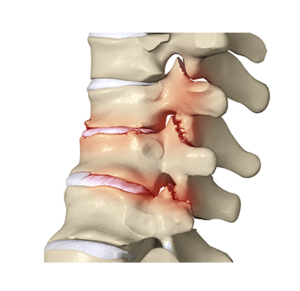What is arthritis of the spine?
Arthritis is a term describing conditions causing pain, tenderness, stiffness and swelling in the joints throughout the body. It is estimated that nearly 50 million Americans experience various forms of arthritis. Arthritis is also a contributing factor to many physical disabilities.
In the United States, approximately 90 percent of people 55 years of age and older deal with some form of arthritis, and it is estimated that by the year 2020, more than 60 million people will have some form of arthritis.
Osteoarthritis and the spine
Due to the amount of pressure they withstand, the spinal joints are particularly prone to developing arthritis. Generally speaking, spinal arthritis occurs in the facet joints, or vertebral joints. These joints connect vertebrae together and are located in rear of the spine. Facet joints facilitate movement in the spine such as bending, twisting and stretching, but these joints often thicken and harden with age, which can lead to osteoarthritis of the spine.
Typically, when a person has been diagnosed with degenerative arthritis of the spine it means that cartilage breakdown has occurred on his or her facet joints. Arthritis of the facet joints can cause slight to severe pain. This pain could potentially radiate along affected nerves to other areas of the body such as the buttocks or upper thighs. As time passes, progressive joint degeneration creates even more frictional pain. The resulting back pain and stiffness decreases back motion and flexibility, particularly when standing, sitting and walking.
Spinal osteoarthritis may also be associated with degenerative disc disease (DDD), a gradual deterioration of the shock-absorbing discs between the vertebrae of the spine, and is confused with DDD in some cases. This is because osteoarthritis and degenerated discs are often found together. However, these are two separate conditions.

Arthritis of the spine and bone spurs
When bone is stressed, it responds by creating more bone in an effort to repair itself. However, the new bone could have a different architecture than the originally stressed bone. Over the years, bone spurs — small, irregular bone growths also called osteophytes — can form on the facet joints and around the spinal vertebrae. Bone spurs typically grow in response to bone-on-bone friction in the spine that can often be caused by arthritis.
As arthritis develops and cartilage wears away, the bony ends of facet joints become exposed. The exposed bones rub directly against each other and bone spurs form. Bone spurs also can develop as the spinal discs become thin and collapse with age. Space between the vertebrae narrows, and eventually, adjacent vertebrae can come in contact with one another, causing bone spurs to form along the edges of the vertebrae.
Bone spurs are a natural response to joint instability – essentially, they are the body’s attempt to help stabilize a deteriorating joint. However, they are no substitute for normally functioning joints and can potentially cause problems in the joints. Bone spurs are a normal part of the aging process and do not necessarily cause pain. However, they can cause the irritation or compression of spinal nerves. This narrowing of nerve passageways in the spinal column is called spinal stenosis.